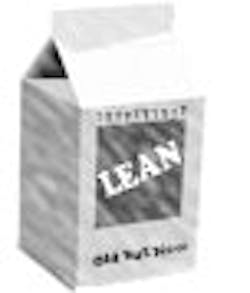Old but New
To some machine control professionals, the subject of lean manufacturing principles seems like a bad penny turning up again.
Theyll groan, mumble something like no, not again, and wont pay it much attention.
Its just not for them, theyve concluded. Lean is what big, multi-location, supply-chain-centric manufacturing companies do. They also eye it a bit suspiciously as a potential company-culture thing that might initially bloom but then wither after the low-hanging opportunity fruit is harvested. Besides, whats it got to do with controls and instrumentation?
So, when we decided it was time this year to have a new look at this old subject, we knew we needed to supply solid user evidence that says lean principles can help industrial OEMs.
I remembered being encouraged by an Automation Fair presentation a year or two ago by Hartness International and Pearson Packaging, two moderately sized outfits that build packaging line solutions. They both had very good, measurable things to say about how lean manufacturing was working in their organizations.
While he researched this cover story (p34), Managing Editor Mike Bacidore said he unearthed so much material that hell extend the discussion with a follow-up article in a few months. Even then hell probably still have a few unresolved issues that need more input from you.
Hell try to get us up to date on how Hartness and Pearson are progressing with their lean initiatives.
Right now he has plenty of user testimony to pass along, so its definitely worth a read.
Another new but old issue appears in the FPGA application article on p48. Its an nice briefing on how an Italian OEM used an FPGA to rein in a particularly demanding hydraulic control loop he didnt trust his PLC to handle.
This got me thinking about the companys decision to embrace an FPGA approach. The technology has been machine control viable for quite a few years, but really hasnt surfaced with a lot of visible supplier support other than the pretty significant commitment National Instruments has made to it.
The machine builder was very familiar with NIs product line and knew what type of support it could expect. So even though the technology was new to them, they were in enough of a comfort zone to decide to try it out.
Is that a limiting factor for most of you? Is a pioneering machine control spirit always dialed back by the fear of being out there on the prairie all by yourselves?
When is the upside of trying something new so compelling that it overcomes the risk of early adoption? I have to think its more than just being pushed into something new by a demanding customer with a do-it-or-else attitude.
Tell us about it here or jump into the conversation in Machine Builder Forum on the website.


